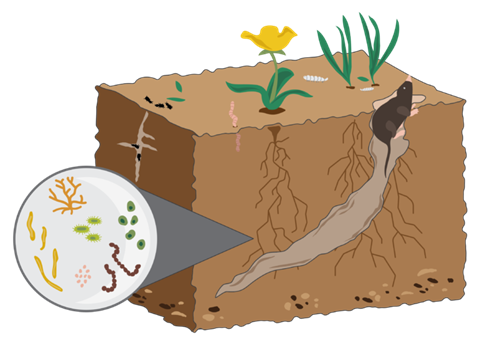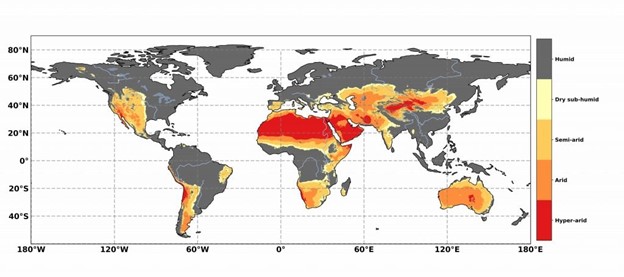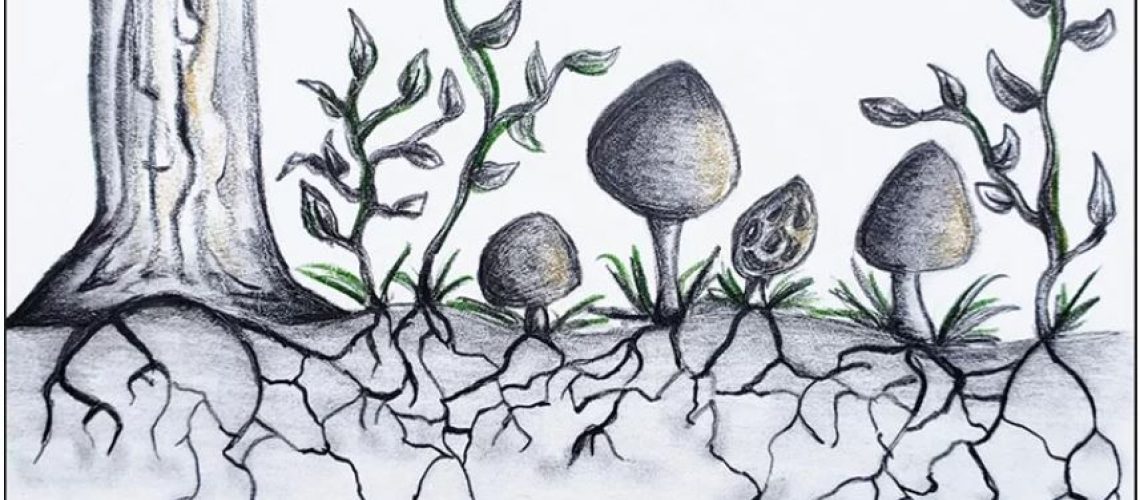Guest Post by Alex Siggers, 2023-2024 Sustainability Leadership Fellow, and Ph.D. Student in the Department of Biology and the Graduate Degree Program in Ecology at Colorado State University
“We could learn from digging down, but no one ever seems to be digging.” -Jack Johnson
Tread carefully: the soil food web
Have you ever taken time to consider that every step you take is likely smushing billions of organisms1? If not, have a little empathy for Pete’s sake. Soil organisms, most of which are microscopic and invisible to the naked eye, shape the world around us in myriad ways. The complex soil food web is composed of bacteria, fungi, protists, nematodes, microarthropods, and earthworms, to name a subset of any given system. Each of these groups interact with each other and their environment to drive processes that are crucial to sustaining life on Earth. For example, bacteria & fungi play particularly important roles in recycling dead plant tissue into the basic nutrients (e.g., nitrogen) that are required for living plants to grow. Further, nematodes (microscopic worms) feed upon bacteria & fungi and are then predated upon by mites, millipedes, and others. Each trophic transfer, or movement up the food chain, leads to deposition of nutrients in different forms, which can alter overall ecosystem nutrient cycling. This “food chain” is a drastic oversimplification of what occurs beneath our feet at any given moment. Thankfully, our understanding of these interactions is expanding rapidly as technology, experimental assessments, and synthesis efforts are improving.

My earlier example of soil ecology does not do justice to what functions soil organisms provide; a more comprehensive list includes improvement of soil fertility via nutrient transformation, soil aggregation, pathogen suppression, carbon storage, biofilm formation, water cycling, and temperature regulation2. Had enough yet? Each of these functions relies upon an intricate ecology, or series of interactions, that can be altered by internal and external drivers. Losing or adding a single “species” can completely change how these processes play out. They are the processes that allow our food to grow, clean the air we breathe, and attempt to keep atmospheric temperatures in check. While our knowledge is growing, so are the threats to the overwhelmingly diverse soil ecosystem.
Threat is a bold word- but maybe not bold enough
You may have encountered information regarding how global climate change may be impacting coastlines via sea level rise, or maybe you have heard individuals link the increasing severity of wildfires to increasing atmospheric temperatures. However, it is much less likely that you have heard how altered climate regimes will impact the ground beneath you. It may be difficult to notice what worms’ responses to increasing drought frequency has to do with you. I challenge you to consider where your last meal came from and the immense number of processes that had to occur just for it to make it into your belly. Hear me out- say you had a big mixed greens salad with a couple of breadsticks. Starting from the top:
- Each fruit, vegetable, and grain you ingest relied upon the crucial transformation of soil nutrients (i.e., a soil microbial process) into a form that they could take up and use to build the (bio)mass that you ingested.
- The soil that they were grown in must be sufficiently aggregated to retain water for the plants to uptake and prevent topsoil from eroding. Soil organisms play a major role in soil aggregation and formation.
- If that produce was not complete mush or covered in spots, it was likely not the victim of soil pathogens. This is largely thanks to interactions between soil organisms (and plants) leading to disease suppression.
While there are a few missing steps, this should be sufficient to point out that we need healthy soils to survive. Now comes the bummer. Human impacts on our planet cascade belowground to alter these processes in ways that we are just now truly beginning to understand. Deforestation and intensive agriculture are driving erosion and mass desertification (degradation of land into desert-like systems), which puts pressure on soils and limits biological activity3,4. Applying fertilizers, pesticides, and herbicides also poses a unique challenge that soil organisms have not had time to adapt to, thus altering the biotic interactions and processes in agricultural systems5,6. Lastly, changes to rainfall patterns, such as increased drought and heavy rainfall frequency, will lead to ecological changes that are largely unknowne.g., 7. While this four sentence summary alone may seem like enough to give up hope, our work has only just begun. As our understanding of belowground processes and aboveground-belowground interactions expands, so does our ability to innovate and generate potential solutions to offset the detrimental impacts of global change.

What role do we have in this mess?
Starting on the individual scale, you have the power to pay attention. Now that you have this background, dig a little deeper into what practices local farmers are using and support those that emphasize more sustainable approaches that conserve soil health (i.e., cover cropping, limited tillage, polyculture). Do not be afraid to compost- whether you use the rich organic material in your own garden or bring them to a local composting center, it makes a difference. Spread the word! Lack of communication about these concepts is often a major reason that folks have limited knowledge of what goes on in the soil. Maximize your involvement with the community around you. Much like the interconnectedness of soils, connecting with other people drives change across scales.
Thankfully, groups have already taken the lead to communicate the importance of soil biodiversity and health to policymakers that have the power to implement countrywide policies promoting soil conservation. The Global Soil Biodiversity Initiative, for example, has already been recognized by the European Union and has joined the European Commission’s Global Coalition for Biodiversity (globalsoilbiodiversity.org). Numerous nonprofits and scientific initiatives have been created to emphasize the importance of the diverse lifeforms beneath our feet, and you can promote the mission of these groups by following, listening, and engaging. It is of the utmost importance that each of us understand and discuss how much is at stake; let us speak up for the under(ground)dogs.
List of soil biodiversity organizations, groups, and projects
- Global Soil Biodiversity Initiative (globalsoilbiodiversity.org)
- Society for the Protection of Underground Networks (spun.earth)
- Discover Life in America (dlia.org)
- Soil Biodiversity Observation Network (SoilBON) (https://geobon.org/bons/thematic-bon/soil-bon/)
- Global Soil Laboratory Network (https://www.fao.org/global-soil-partnership/glosolan/en/)
- Convention on Biological Diversity (https://www.cbd.int/)
- Rodale Institute (rodaleinstitute.org)
- See https://www.globalsoilbiodiversity.org/soilrelated-organizations for a more holistic list
References
- Chaparro, J. M., Sheflin, A. M., Manter, D. K. and J. M. Vivanco. 2012. Manipulating the soil microbiome to increase soil health and plant fertility. Biology and Fertility of Soils 48:489-499.
- Paul, E. and S. Frey. 2023. Soil microbiology, ecology and biochemistry. Elsevier.
- Moreno‐Jiménez, E., Maestre, F. T., Flagmeier, M., Guirado, E., Berdugo, M., Bastida, F. et al. 2023. Soils in warmer and less developed countries have less micronutrients globally. Global Change Biology 29: 522–532.
- Guerra, C. A., Berdugo, M., Eldridge, D. J., Eisenhauer, N., Singh, B. K., Cui, H. et al. 2022. Global hotspots for soil nature conservation. Nature610: 693–698.
- Kalia, A. and S. K. Gosal. 2011. Effect of pesticide application on soil microorganisms. Archives of Agronomy and Soil Science 57: 569-596.
- Geisseler, D. and K. M. Scow. 2014. Long-term effects of mineral fertilizers on soil microorganisms- A review. Soil Biology and Biochemistry 75: 54-63.
- Vilonen, L. L., Hoosein, S., Smith, M. D. and P. Trivedi. 2023. Legacy effects of intensified drought on the soil microbiome in a mesic grassland. Ecosphere 14: e4545.






